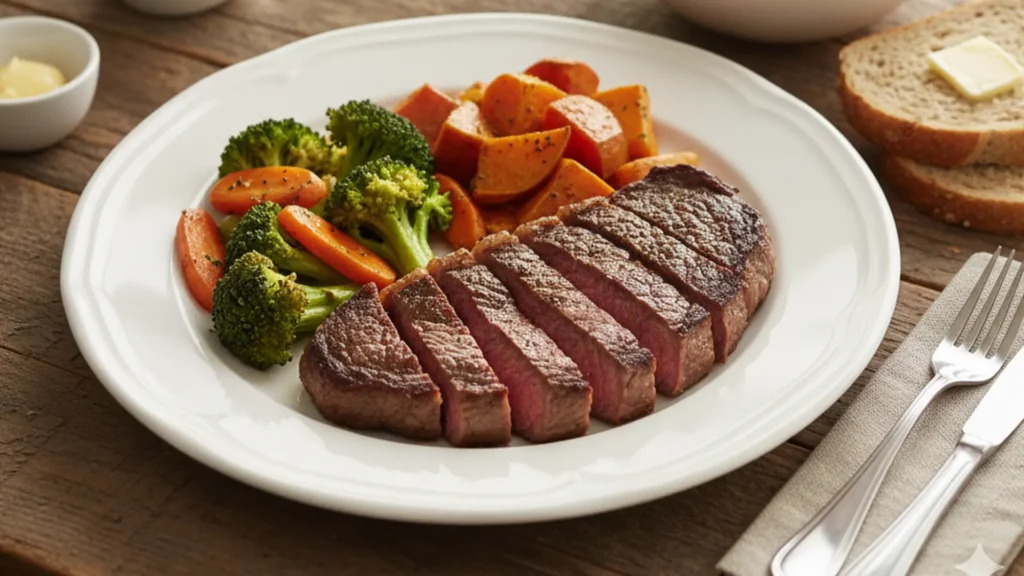What if the food on your plate could shape how strong, sharp, and independent you feel every single day? For seniors, this is not just a theory—it is reality. Nutrition affects energy, memory, bone health, and the risk of disease. The right meal plan can make the difference between feeling limited and feeling free.
This is why building the perfect plate matters. Every bite you take has the power to support or weaken your body as it ages. The good news is that balanced meals are not complicated or stressful. Once you know the key parts, you can create them at home without confusion. Today, we will break down exactly how to do this step by step.
Foundation of the Perfect Plate
Balanced meals mean more than just eating enough. They mean eating in a way that fuels your body with the right mix of nutrients. Seniors need protein for muscle strength, fiber for digestion, healthy fats for the brain, and vitamins for immune defense. Each of these plays a special role in keeping your body strong.
Here’s the foundation of the perfect plate:
- Half of the plate should be fruits and vegetables.
- One-quarter should be lean protein.
- One-quarter should be whole grains.
- Add healthy fats in small amounts.
- Finish with water or milk instead of sugary drinks.
This setup gives your body steady energy, keeps your heart healthy, and lowers the risk of illness. It also helps you maintain weight without needing strict diets. Already, you can see how clear this formula is, but the real value comes when we dive deeper into each piece.
The Core Elements You Must Not Miss
Protein is the first key. Without it, muscles weaken, and balance declines. Seniors need protein at every meal, not just at dinner. Eggs, fish, chicken, beans, lentils, and yogurt are simple choices. Each serving should be about the size of your palm.
Next is fiber. Constipation is one of the most common complaints in aging, and fiber is the solution. Whole grains, brown rice, oats, beans, and fresh fruits keep digestion smooth. They also protect your heart and control blood sugar. Adding just one extra serving of high-fiber food per day can make a major difference.
Do not forget healthy fats. These keep your brain sharp and your joints flexible. Sources include olive oil, nuts, seeds, and fatty fish such as salmon. A spoonful of olive oil on vegetables or a handful of walnuts as a snack is enough. You do not need large amounts—just steady, small servings.
Finally, focus on vitamins and minerals. Calcium and vitamin D protect bones. Vitamin B12 keeps nerves and memory strong. Potassium supports blood pressure. You can get these from leafy greens, dairy products, fortified cereals, bananas, and citrus fruits. When your plate has color, your body gets what it needs.
How to Turn Balance Into Daily Action
Knowing what to eat is powerful, but living it daily is where the real payoff happens. Many seniors struggle with meal planning, shopping, and cooking. That is where simple strategies make all the difference. Turning nutrition into small, repeatable steps keeps meals stress-free and enjoyable.
Plan simple meals. Balanced meals do not need long recipes or many ingredients. Breakfast could be oatmeal topped with fresh berries and a spoon of yogurt for protein. Another option is scrambled eggs with spinach and whole grain toast. For lunch, a tuna sandwich on whole grain bread with sliced cucumber and tomato works well. A simple bowl of vegetable soup with beans or chicken is another choice. Dinner could be grilled chicken, brown rice, and steamed broccoli with olive oil. You could also try baked fish with sweet potato and green beans. Each of these follows the balanced plate rule without confusion.
Make shopping easy. Write a short grocery list each week. Include lean proteins, colorful fruits, vegetables, and whole grains. Buy frozen vegetables or pre-cut produce if chopping is hard. These are just as healthy as fresh and last longer. Stock your pantry with canned beans, oats, whole grain pasta, and olive oil. This makes it easier to cook balanced meals without last-minute stress.
Watch portion sizes. As you age, your body may need fewer calories, but the need for nutrients stays the same. That means the size of your meals should be smaller, but the quality should stay high. A smaller plate can help keep portions in check without feeling deprived. For example, half the plate should be vegetables, one-quarter lean protein, and one-quarter whole grains. Adding fruit on the side instead of extra bread is a simple swap that gives more vitamins without too many calories.
Stay hydrated. Many seniors confuse thirst with hunger, leading to overeating. Water, milk, or herbal teas should be the main drinks. Sugary sodas and juices add calories without nutrients. Keep a water bottle or glass nearby throughout the day. Try drinking a glass of water before each meal. If plain water feels boring, add lemon slices, cucumber, or mint for flavor. Staying hydrated supports digestion, energy, and clear thinking.
Add variety. Eating the same foods every day may feel easy, but it can cause gaps in nutrition. Rotate proteins, fruits, and vegetables weekly. For example, switch between chicken, fish, turkey, eggs, and beans. Try different grains such as brown rice, quinoa, or barley. Rotate vegetables by color: green leafy vegetables one day, orange carrots the next, and red tomatoes the day after. This keeps meals exciting and ensures a wide range of vitamins and minerals.
Plan ahead. Cooking daily may feel tiring, but planning ahead makes it easier. Prepare extra portions at dinner and save them for the next day’s lunch. Chop vegetables in bulk and store them in containers. Cook a big batch of soup or stew and freeze small servings for later. Having ready-to-eat healthy options reduces the temptation to skip meals or choose fast food.
Use snacks wisely. Healthy snacks help maintain steady energy. Keep fruit, nuts, yogurt, or cut vegetables ready for quick bites. Avoid chips, pastries, or candy, which give energy spikes followed by crashes. A small apple with peanut butter or a handful of almonds is a smart snack. Snacks should support meals, not replace them.
Listen to your body. Aging can change appetite and digestion. Some seniors feel less hungry, while others crave sweets more. Pay attention to how foods make you feel. If dairy causes discomfort, try lactose-free milk or yogurt. If heavy meals feel tiring, eat smaller meals more often. Balanced eating is not only about rules but about comfort and consistency.
The truth is, once you know these steps, balanced eating becomes automatic. You are no longer guessing what is good for you—it is already mapped out. The perfect plate turns into a habit when you plan meals, watch portions, drink water, add variety, and prepare ahead. With practice, your daily choices add up to long-term strength, energy, and health.
What the Perfect Plate Gives You
This is where everything comes together. The perfect plate is not only about food. It is about how you feel each day and how much freedom you have in your life.
Balanced meals build strength. Stronger muscles mean less risk of falls. Good nutrition fuels energy, so you can walk, garden, travel, or play with grandchildren without fatigue. A sharp brain from healthy fats and vitamins means you stay engaged in conversations and decisions. Strong bones and a healthy heart mean more years of independence.
But the payoff goes beyond health. Eating balanced meals removes stress about food choices. No more confusion about diets or conflicting advice. You have a simple formula that works. This peace of mind is powerful. It makes eating enjoyable again instead of a source of worry.
Balanced meals also prevent future problems. Many illnesses connected with aging—diabetes, heart disease, weak bones—can be delayed or controlled by what you put on your plate. Each balanced meal is an investment in future independence. That is the greatest return you can give yourself.
Healthy aging is not about strict rules. It is about smart choices repeated daily. The perfect plate makes those choices easy. Half fruits and vegetables, one-quarter protein, one-quarter whole grains, with healthy fats and proper hydration—that is the simple formula.
You now have the exact blueprint. You know the foundation, the core elements, the daily steps, and the long-term payoff. Each part builds on the last, and the end result is freedom, strength, and peace of mind.
The best part is this: balanced meals are within your reach starting today. You do not need special products or complicated recipes. All it takes is using the perfect plate as your guide. From breakfast to dinner, every plate can move you toward a longer, stronger, and healthier life.




